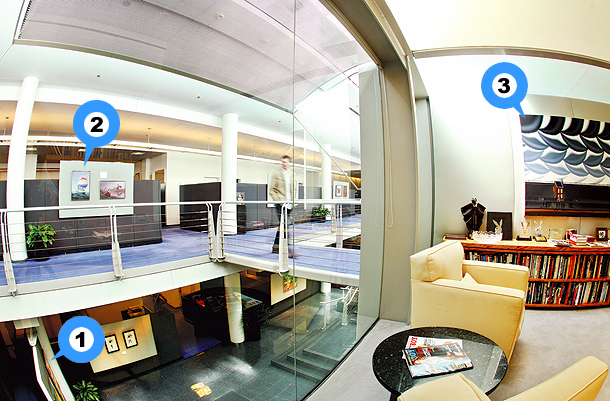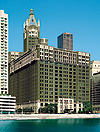Playboy Enterprises CEO Christie Hefner’s fishbowl office on the 15th floor of Lake Shore Place (680 N. Lake Shore Drive) sits in the middle of Playboy‘s corporate offices. Her office looks out over heavily trafficked hallways and black cubicles and offers views of selections from Playboy‘s 4,000-piece art collection, which rotates around the office twice a year.

The Design
Inside her office, Hefner’s as exposed as a Playmate centerfold. “I designed our office space specifically to reflect Playboy‘s ‘open door’ policy,” she explains. “By the executives’ being visible to employees rather than behind closed doors in a corner office, it sends the message that we are accessible. I also personally appreciate seeing the changing art exhibits and watching who’s in town visiting.”
The Location
|
Occupying the top two floors of the old American Furniture Mart, Playboy moved into the 95,523-square-foot office in 1989. (Previously, the company called Michigan Avenue’s Palmolive Building its home.) Although the structure appears to be one building, it’s actually two: the east end, where Playboy‘s offices are located, was originally built in 1924 by architects Henry Raeder and George Nimmons, and is made of reinforced concrete. Two years later, Nimmons added a 29-story steel-frame tower with an ornate blue roof inspired by England’s Houses of Parliament. In 1984, the building’s interior was renovated to make it a mixed-use building of residential apartments, offices, and stores.
|
1. Can-Am Races at St. Jovite This brightly colored 1970 oil painting by LeRoy Neiman, a longtime Playboy contributor, depicts the motor sport races in Quebec. Not long after Hugh Hefner founded the magazine in 1953, he commissioned Neiman, then a teacher at the School of the Art Institute, to create artwork for a monthly feature called “Man at His Leisure.” Neiman went on to become the magazine’s artist in residence.
|
2. Another Playboy regular, Martin Hoffman, painted Pick of the Day Sailors in 1971, one of his many illustrations for the magazine that reflect the Playboy lifestyle-in this case, a sailing outing on the high seas with, naturally, bikini-clad babes.
3. Roger Brown, a leading Chicago Imagist painter in the late 1960s and early 1970s, painted Used in Evidence for a work of fiction by Frederick Forsyth, published in Playboy‘s December 1979 issue. The magazine helped boost the fortunes of several local artists like Brown (as well as Karl Wirsum and Ed Paschke, among others) beyond Chicago.
Photography: (Images 1, 3 and 4) Peter Wynn Thompson/Courtesy of Playboy; (Image 2) Erich Schrempp, Courtesy of Golub & Company LLC.





